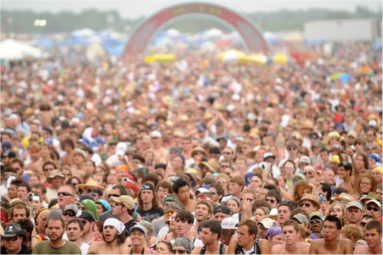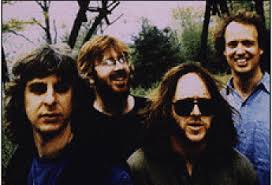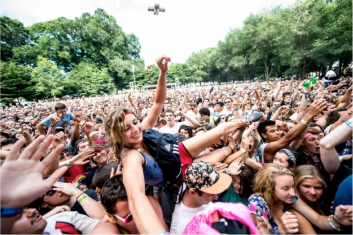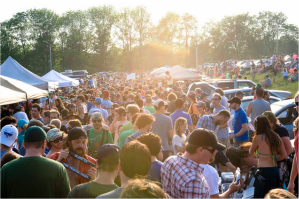– Photo: Trey, Page, Mike, and Fish early in their career.
Phish, the Vermont based psychedelic jam band, have become defined by their extended live sets, musical improvisation, blending of musical genres (jam-rock, jazz-rock, neo-psychedelia, folk/funk), and most importantly, their extremely dedicated and widely ranging fan base. The band’s lineup, “Trey, Page, Mike, and Fish,” includes Trey Anastasio (guitarist), Jon Fishman (drummer), Mike Gordon (bassist), and Page McConnell (keyboardist) – with all members contributing vocals. From their early beginnings as a Grateful Dead cover band at the University of Vermont, Phish has been contributed with filling a cultural void – much like the Grateful Dead – and in doing so, creating a group of “insiders” that have gained and invaluable set of knowledge relating to the social constructions and communities of this world. However, their live concerts have been, and always will be, the staple of their almost “unlikely” success.

– Photo: Phish phans awaiting the show at Bonnaroo music festival.
It is telling that, unlike almost all successful bands of the past three decades, Phish has received very little radio play or mainstream exposure. In fact, no other band within the last five decades has sold as many albums as Phish while at the same time, airing hardly any of their music via radio or television. It has been said that people most often hear of phish before they hear phish. Because of this, Phish owes their credit primarily to “word of mouth” and the exchange of live concert recordings, and it has been through this medium that Phish has gone on to sell more than eight million albums in the United States alone. This is an example of the scope Phish-fandom extends to outside of the mainstream media. Not only does Phish culture contribute directly to the band’s overwhelming popularity, but it thrives without the aid of popularity-based exposure. This not only serves as exemplary evidence of the largely original nature of Phish-fandom, but of their unique capacity to apply their love for Phish in external arenas in a meaningful and dedicated fashion.
– Photo: Crowd surfing at a Phish concert during the Bonnaroo music festival.
A Phish concert is defined by set of communal and aesthetic characteristics that hold the potential to radically change the lives of those who choose to attend. I can say from personal experience, and from talking to dozens of actual concert attendees, that the bond created within the Phish concert setting between those who share the experience is as strong as it is instantaneous. Phish presents music in such an original and extraordinary manor that they are able to elicit strong feelings of communal good will and mutual reciprocity in their fans by means of an pathos appeal, and it is because of these authentically manifested musical interventions that they have gained such a cult-like following. Just simply listening to a phish song on Spotify, Youtube, or iTunes will not illicit these feelings, and therefore will not have such a defining impact on the listener. Raffalo analyzes a similar environment in Camp Randall Stadium, finding that the presence of the student section’s energy and school spirit directly contributes to the unforgettable environment of the stadium itself.
– Photo: Shakedown Street at a local Phish concert.
Perhaps the most evocative example of Phish fans both shaping and occupying their own culture is the cavalcade of Phish fans and bootleg “vendors” outside of every Phish concert, otherwise known as Shakedown Street. Here, fans who coin themselves as “wookies,” or people who attend Phish concerts for a living, not only sell anything and everything imaginable, but live within an environment that is original in every sense of the word. Literally anything under the sun can be found within this makeshift line of cars and tents: from tie dye shirts to micro-brewed beer and LSD-laced gummy bears, this is not only the heart of Phish fan culture, but a representation of a fan-created space where communal bonding can take place and imaginative, artistic expression is encouraged outside of the physical concert. In fact, many of the fans that occupy and contribute to the set-up of this street do not even attend the actual concert, but would rather spread the communal aspects of their fan-created genre to newcomers.
What sets the Phish fan community apart from fans of other various bands stems from not only their novelty, but their ability to utilize their passion for musical expression in the establishment of a community rooted in self-improvement. This can been seen in the classroom where Phish lyrics and concert settings are used for academic purposes as well as at the actual concert venues where newcomers are welcomed with open arms into a community that fosters a strong sense of social inclusivity. It must be recognized that these cultural communities all trace their roots back to the live Phish concert itself. I know of no other musical arena that fosters such a communal and culturally rooted fan base, and I know of no one more generous and loving than a Phish fan.
Give the live video below a listen. The song – “Slave to the Traffic Light”


